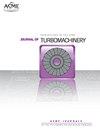INFLUENCES OF LASER INCIDENCE ANGLE AND WALL THICKNESS ON ADDITIVE COMPONENTS
IF 3.1
3区 工程技术
Q3 ENGINEERING, MECHANICAL
引用次数: 0
Abstract
Additive manufacturing (AM), particularly laser powder bed fusion, is growing the ability to rapidly develop advanced cooling schemes for turbomachinery applications. However, to fully utilize the design and development opportunities offered through AM, impacts of the build considerations and processing parameters are needed. Prior literature has shown that specific build considerations such as laser incidence angle and wall thickness influence the surface roughness of additively made components. The objective of this technical brief is to highlight the effects of both laser incidence angle and wall thickness on the surface roughness and cooling performance in micro-sized cooling passages. Results indicate that for any given laser incidence angle, surface roughness begins to increase when wall thickness is less than 1 mm for the cooling channels evaluated. As the laser incidence angle becomes further away from 90° the surface roughness increases in a parabolic form. Laser incidence angle and wall thickness significantly impacts friction factor, while there is less of an influence on Nusselt number for additively manufactured microchannels.激光入射角和壁厚对加性组分的影响
增材制造(AM),特别是激光粉末床聚变,正在提高快速开发用于涡轮机应用的先进冷却方案的能力。然而,为了充分利用AM提供的设计和开发机会,需要考虑构建因素和处理参数的影响。现有文献表明,激光入射角和壁厚等特定构造因素会影响添加制造部件的表面粗糙度。本技术简报的目的是强调激光入射角和壁厚对微型冷却通道表面粗糙度和冷却性能的影响。结果表明,对于任何给定的激光入射角,当评估的冷却通道的壁厚小于1mm时,表面粗糙度开始增加。随着激光入射角越来越远离90°,表面粗糙度以抛物线形式增加。激光入射角和壁厚显著影响摩擦系数,而对额外制造的微通道的努塞尔数影响较小。
本文章由计算机程序翻译,如有差异,请以英文原文为准。
求助全文
约1分钟内获得全文
求助全文
来源期刊
CiteScore
4.70
自引率
11.80%
发文量
168
审稿时长
9 months
期刊介绍:
The Journal of Turbomachinery publishes archival-quality, peer-reviewed technical papers that advance the state-of-the-art of turbomachinery technology related to gas turbine engines. The broad scope of the subject matter includes the fluid dynamics, heat transfer, and aeromechanics technology associated with the design, analysis, modeling, testing, and performance of turbomachinery. Emphasis is placed on gas-path technologies associated with axial compressors, centrifugal compressors, and turbines.
Topics: Aerodynamic design, analysis, and test of compressor and turbine blading; Compressor stall, surge, and operability issues; Heat transfer phenomena and film cooling design, analysis, and testing in turbines; Aeromechanical instabilities; Computational fluid dynamics (CFD) applied to turbomachinery, boundary layer development, measurement techniques, and cavity and leaking flows.

 求助内容:
求助内容: 应助结果提醒方式:
应助结果提醒方式:


